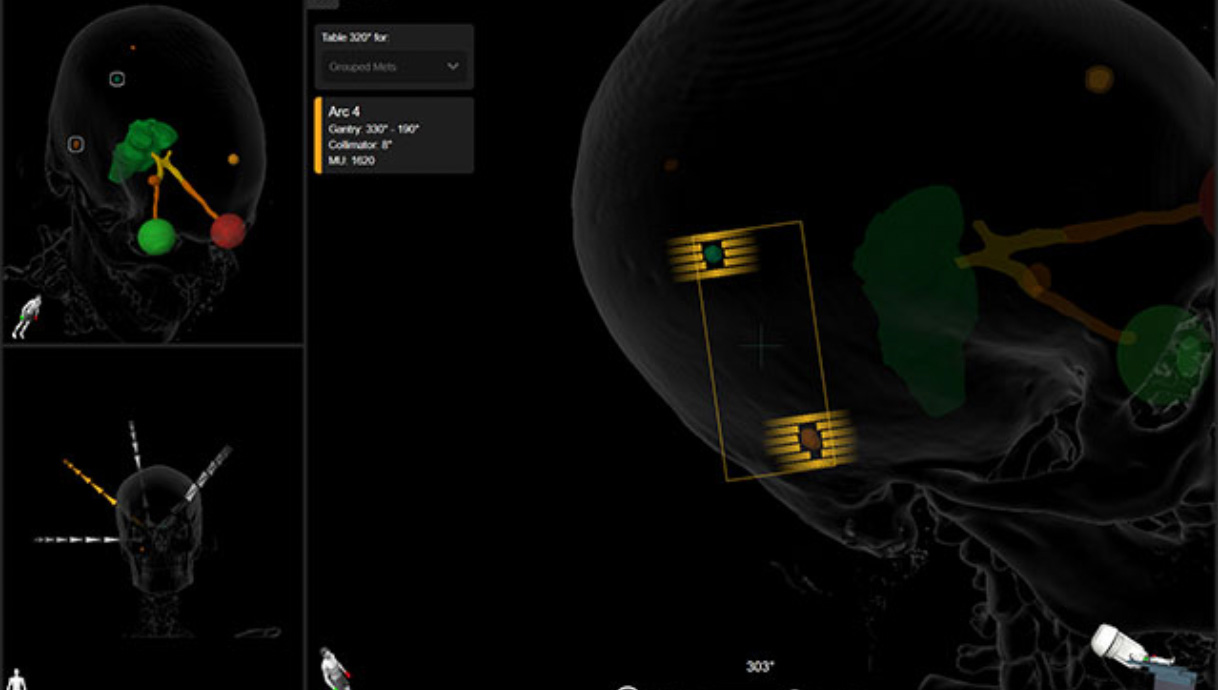
Provider Corner
FEATURING:


Q&A with Dr. Michael Vogelbaum on Stereotactic Radiosurgery for Brain Tumors

We sat down with Dr. Michael Vogelbaum, Program Leader of Neuro-Oncology and Chief of Neurosurgery, to discuss stereotactic radiosurgery for brain tumors.
What is stereotactic surgery and how is it different from radiation therapy?
 Stereotactic radiosurgery is a non-invasive treatment that is delivered with the highest precision, like a neurosurgical procedure, but without an incision. It is a type of highly-targeted radiation used to treat small brain tumors. A digital treatment guidance system is used to generate narrow beams of high-dose radiation, which are precisely aimed at a cancerous lesion from multiple angles. The treatment itself requires just a single dose or a few daily doses. Conventional radiation therapy is used to treat broad regions of the brain, including both tumor tissue and brain tissue in the treatment field. While that may be the appropriate treatment for some types of tumors that spread diffusely, stereotactic radiosurgery is more appropriate for highly localized tumors, such as brain metastases.
Stereotactic radiosurgery is a non-invasive treatment that is delivered with the highest precision, like a neurosurgical procedure, but without an incision. It is a type of highly-targeted radiation used to treat small brain tumors. A digital treatment guidance system is used to generate narrow beams of high-dose radiation, which are precisely aimed at a cancerous lesion from multiple angles. The treatment itself requires just a single dose or a few daily doses. Conventional radiation therapy is used to treat broad regions of the brain, including both tumor tissue and brain tissue in the treatment field. While that may be the appropriate treatment for some types of tumors that spread diffusely, stereotactic radiosurgery is more appropriate for highly localized tumors, such as brain metastases.
Working together as a multidisciplinary team, a radiation oncologist, a physicist and a neurosurgeon define the treatment plan by utilizing several advanced techniques and technologies, including three-dimensional imaging and localization to locate the lesion and determine its exact size, shape, and coordinates within the head. Then, during each treatment session, real-time imaging guidance is continually used to allow for instant adjustments as needed, and a special device is used to carefully hold the patient’s head as still as possible for even greater accuracy.
When is stereotactic radiosurgery used?
Stereotactic radiosurgery is most often used to:
- Treat brain metastasis, which is cancer that has spread to the brain from a variety of sites including the lung, breast, skin (melanoma), colon, or kidney.
- Treat small meningiomas, acoustic neuromas, pituitary tumors, or skull base tumors either as a first treatment or at the time of tumor regrowth.
- Address other types of brain tumors (or parts of brain tumors) that cannot be removed safely because they are difficult to access, subject to movement, or situated very close to sensitive structures in the brain or spinal cord.
Does the use of stereotactic radiosurgery involve a collaborative team of experts?
At Moffitt Cancer Center, we precisely tailor our brain tumor treatment recommendations to the exact diagnosis and characteristics of each patient.
When a patient will benefit from stereotactic radiosurgery, a team of experts including radiation oncologists, neurosurgeons, radiation therapists, medical physicists, dosimetrists, and supportive care providers works together on a treatment plan.
This multidisciplinary team has great expertise in treating many different types of benign or malignant tumors, including hard-to-access tumors of the brain and spinal cord. We also offer other advanced forms of radiation therapy, including three-dimensional conformal radiation therapy (3D CRT) and intensity-modulated radiation therapy (IMRT).
What are you excited about in terms of emerging therapies for brain tumors or brain metastasis?
Stereotactic radiosurgery has been the primary treatment for most patients with brain metastases for decades. More recently, we have been able to translate our improved understanding of cancer biology to identify tumor targets that can be attacked with new types of drugs. These developments have led to improvements in the survival and quality of life of patients with brain metastases, but we are still looking to produce cures. The multidisciplinary team at Moffitt recently published a research article in a major scientific journal, entitled "Improving Brain Metastases Outcomes Through Therapeutic Synergy Between Stereotactic Radiosurgery and Targeted Cancer Therapies." This report highlighted our approach to finding synergies between stereotactic radiosurgery and new types of targeted therapies and immunotherapies. These synergies have improved the outcome for patients with non-small cell lung cancer, breast cancer (including those with HER-2 positive, endocrine receptor-positive tumors), melanoma and renal cell carcinoma brain metastases.
While stereotactic radiosurgery has been a mainstay of treatment for brain metastases, recent advances in targeted therapies and immunotherapies have provided additional options for certain groups of patients with brain metastases. We are now exploring combinations of these treatments that may provide even better cancer control within the brain.
Provider Corner
Subscribe to our Newsletter
GMMI is a leading URAC accredited, ISO 9001:2015 & ISO/IEC 27001:2013 certified provider of cost containment and medical risk management solutions.
We are Passionate for People.
Focused on Client Results.
Driven by Legendary Service.
Our SOlutions
Contact Us
Phone Number: +1 (954) 370-6404
Toll-Free (in the U.S. & Canada):
800-682-6065
Email: info@gmmi.com
2024 © All Rights Reserved.
Code of Conduct | GDPR | PIPEDA | Terms of Use | Privacy Policy | California Privacy Notice | Personal Data Access Form | Responsible Data Leak Disclosure Form






